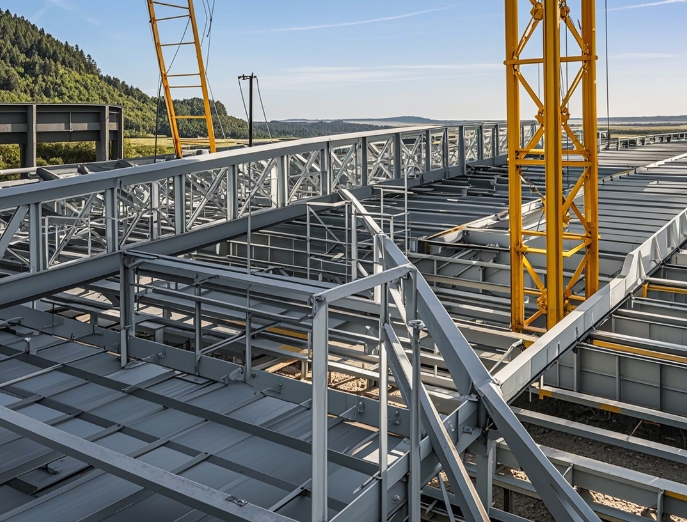Grid structure design specification
更新时间:2020-12-30 09:37:05•点击:52458 • Grid Knowledge

The design code for grid structure includes some conventional basic requirements and relevant national standards of the construction industry:
1. The basic requirements of grid structure design
1. The selection of the grid frame should be combined with the project's plan shape and span size, supporting condition, load size, roof structure, building design and other requirements through comprehensive analysis and determination. The network structure must ensure that there is no structural geometry change. Note: The division of large, medium and small spans in this regulation is for the roof. The large span is more than 60m. The middle span is 30m-60m. The small span is less than 30m.
2. Peripheral support grids with rectangular planar shape, when the side length ratio (long side/short side) is less than or equal to 1.5, it is advisable to choose diagonally placed quadrangular pyramid grids, checkerboard-shaped quadrangular pyramid grids, and positively emptied four corners Cone grid, two-way orthogonal diagonally placed grid, two-way orthogonally placed grid, and square pyramid grid. For small and medium spans, star-shaped quadrangular pyramid grids and honeycomb-shaped triangular pyramid grids can also be used. When the building requires unequal length and width in two directions, a two-way oblique grid can be used.
3. The peripheral support grid with rectangular planar shape, when the side-length ratio is greater than 1.5, it is advisable to use the two-way orthogonal vertical grid, the positive quadrangular pyramid grid or the positive quadrangular pyramid grid. When the side length ratio is less than 2, the diagonally placed quadrangular pyramid grid can also be used. When the plane is long and narrow, a one-way broken line grid can be used.
4. The plane shape is rectangular. The grid frame with three sides supporting and one opening can be selected according to 2.0.3. The opening side can be adopted to increase the number of grid layers or appropriately increase the height of the entire grid. The opening side of the grid must be Form vertical or inclined side trusses.
2. The construction industry standards stipulated by the state that the grid structure design follows
The design and calculation of the grid structure should follow the current relevant national or industry standards. These standards include: "Grid Structure Design and Construction Regulations", "Building Structure Load Codes", "Steel Structure Design Codes", "Cold Formed Thin-Wall Steel Structure Technical Codes", "Building Seismic Design Codes", etc.
The grid structure is a high-order statically indeterminate space frame structure. It is very difficult to analyze its internal force and deformation very accurately. Therefore, the calculation of the grid structure must be the same as other structures to ensure the safety of the structure. Under the premise, proper simplification of node stiffness, support conditions, member deformation, etc. are carried out to adapt the calculation method to engineering needs. The general calculation principle of the grid structure is:
(1) The internal force and deformation of the grid structure should be calculated under the external load, and the internal force and deformation under the action of earthquake, temperature change, support settlement and construction and installation load should be calculated according to the specific situation. The above calculations can be carried out in an elastic phase.
(2) The influence of node stiffness can be ignored in structural analysis. The nodes are assumed to be spatially hinged nodes, and all members only bear axial force.
(3) The external load is based on the principle of static equivalent, and the load in the area under the jurisdiction of the node is concentrated on the node. However, when there is a local load acting on the member, the influence of the local bending moment should be additionally considered.
(4) The support conditions can be assumed to be hinged supports or elastic supports that can be moved sideways in one direction or two directions, or without side movement, according to the rigidity of the support structure and the structure of the support nodes.
At present, the calculation model of the grid structure can be divided into three types, namely, the calculation model of the space articulated rod system, the calculation model of the cross beam system and the calculation model of the plate system. The spatial hinged beam system calculation model simplifies the grid into a hinged rod assembly with two-force rods as the calculation unit; the cross beam calculation model simulates the grid as a cross beam system and uses beam segments as the calculation unit , First obtain the internal force of the beam and the node displacement, and then back to obtain the internal force of the member. According to whether the influence of shear deformation is considered, there are various calculation methods; the calculation model of the plate system is to simulate the grid frame as orthotropic or For an isotropic flat plate, the internal force of the plate is calculated first, and then the internal force of the rod member is calculated back. If this calculation model does not consider the influence of shear deformation, it is called the pseudo-plate method; if the influence of shear deformation is considered, then It is called the pseudo-sandwich method.
To sum up, Jiangsu Huahai Steel Structure Co., Ltd. reminds everyone that if you are looking for a grid structure design partner, you must find a strong and established company, and strictly follow the basic requirements of grid structure design and the national construction industry standards. Otherwise, The safety factor is not up to standard and harms others and yourself!
Recommended Reading
-
Full analysis of seismic design and maintenance of grid structure
2025-02-27 16:16:52•1259477 次
-
What are the key process points to follow in order to ensure the quality of grid processing?
2025-02-27 11:21:00•151865 次
-
What type of construction is the grid mainly suitable for?
2025-02-25 16:42:00•148494 次
-
Quality control requirements of grid manufacturers!
2025-02-25 16:02:44•283706 次






